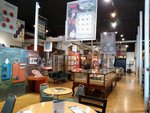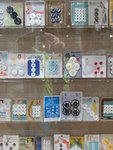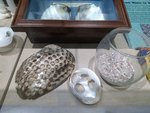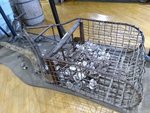



“It’s kind of intriguing, in my mind, to start this story with a fish in 1840,” Bruce Hochstetler says. Let’s begin there.
A channel catfish glides through the dark waters of the Great River. He’s hungry, and the tastebuds covering the surface of his smooth body prickle with the sense of something tasty nearby. He moves in close to a dark mapleleaf mussel, half hidden in a blanket of sand at the river bottom. A worm-like extension twitches from a sliver of opening between the mussel’s matched shells. The catfish lunges for it, stealing the morsel before swimming up and on with the night’s slow current.
The pregnant mussel’s trick worked, and the catfish has no idea he’s been infected. The tiny larvae that clung to that bewitching “worm” now wriggle across his skin and attach themselves where they feel comfortable, on his skin, along his gills. It will be months before he’s free of them.
The glochidia, as the larvae are called, leech the nutrients they need from their catfish host, unconcerned with his needs. Gradually they transform, growing their own flesh, their own set of protective shells. When the time feels right, they release their grasp on the catfish and sink to the floor of the Mississippi. Now fully formed mapleleaf mussels, they disappear into the sand and rocks ten feet below the water’s surface.
Here they could live several decades, perhaps a century. From the water they filter out oxygen and food – phytoplankton, zooplankton, and bacteria – thus keeping themselves fed and the river clean.
The mussels have a secret. If you could pick one up and pry apart those twin shells, if you could get past that unassuming brown, ridged surface, if you could look inside, you would find glorious white iridescence. You would find nacre, a light-throwing composite of hexagonal plates of calcium carbonate. You would find mother of pearl.
It was a good secret. But they couldn’t keep it forever.
A master craftsman from Hamburg, Germany lurked about the shoreline at Muscatine in 1891. John Boepple created buttons from natural substances like horn and bone back in his homeland, and he had heard about the freshwater mussels’ pearl-like lining. He wanted the mussels. He could make an American fortune on pearl buttons.
Clammers lined the Mississippi with traps and pulled hundreds, thousands of mussels up from the water and into the open air. That beautiful mother of pearl could indeed be turned into buttons, although Boepple wouldn’t be apt enough to profit from it.
Button factories sprung up throughout Muscatine, employing men to punch blank disks from the shells and polish them into finished buttons. The buttons were sewn on cards and shipped around the world. By the early 1900s, 1.5 billion buttons were produced in Muscatine every year, turning the city into the Pearl Button Capital of the World. A third of the world’s button supply was crafted on that shoreline.
It could never have lasted. The mussels’ reproductive and growth cycles could never keep up with that level of harvesting. Even with mussels being dredged from new, previously untouched beds in Arkansas, Ohio, and Tennessee, and sent to Muscatine by barge and rail, nature couldn’t keep apace. Neither could fashion. Nor could technology.
By the 1940’s, pearl buttons were out, and plastic buttons were in. You couldn’t sell a pearl button to save your life.
For decades, there had been so much leftover waste. Millions of mussel shells with round holes punched in them. Shell fragments. Button discards. People used the shell leftovers to level their land or supplement their animal feed. Factories would give their shell waste to anyone who would haul it away. It was buried. It was stored. It was forgotten.
In late summer, 2021, Bruce Hochstetler found a little white disk when he cleaned out his purple martin houses. He thought it was interesting, so he put it in a drawer. Then he forgot about it.
Hochstetler lives on a farm near Wellman where he custom-grazes organic stock on one portion of his land and raises a beef herd conventionally on another. In winter, he’s a woodworker for Schlabaugh and Sons, making things, putting things together.
“Digging through a bird nest is kind of an odd pastime,” he acknowledges.
“Most martin landlords clean out their nests when the young are fledged. It’s not the highlight of the martin year, it’s just a chore they’ve got to do. So, they’re not looking for anything. I mean, they know what’s in there. It’s not nice,” he laughs.
Hochstetler has been housing purple martins for five or six years in a tower of twelve plastic gourds. “It can be a trick to get them to come initially,” he says.
Purple martins are colony birds; once they establish a nesting site, they return to it year after year, along with their friends and relatives. Subadults, birds that fledged the previous year, will be looking for their first summer homes, and new martin landlords hope to attract them. Once a pair settles into a place, filling one’s gourds with an expanding colony becomes easier.
Most purple martins winter in Brazil and then migrate back to North America in the spring; in Iowa, they might return in March. About a month after they arrive, they take a few weeks to fill their gourds with nesting material like twigs, straw, mud, and a lining of green leaves. Then they’re free to get on with the business of mating, incubating eggs, and raising the next generation. By the beginning of August, they’re back on the wing, flying 5,000 miles south to overwinter.
That’s when Hochstetler took down the vacated gourds and shook out the nesting material again this past summer. And once again, he found those little round disks. But this time, a few of them had holes in them. This gave him pause.
He had wondered if the disks were plastic left from the punched-out drainage holes in the bottom of the gourd, but the material seemed natural. He had considered fish scales, but the material was too thick.
“You can’t look at that and say, well, that could happen in nature,” he says, holding up one of the white pieces. “Four perfectly drilled holes, perfectly spaced. You know, that’s a button.”
Hochstetler took to the internet and unraveled the thread, from purple martins to pearl buttons to Muscatine.
“This was all new to me,” he says. “I didn’t know about the button industry.”
The button industry has been long dead. How did a button punched and polished 100 years ago, in a place 50 miles away, end up inside his martin houses?
The birds were already well on their way to Brazil, so they couldn’t be interrogated. Hochstetler would have to figure it out without their help. Where were they finding these buttons? And why were they flying home with them?
The first question would prove easier to answer.
“After I determined that they were buttons from freshwater mussels, I started being very curious about my neighbors who also had martins,” Hochstetler told listeners during his presentation on the Bird Observation Conference Call. “The first neighbor I checked with, it didn’t take long [for us] to find a few in his gourds. The third person I visited. . . his martins had gathered several times, three to four times, more of these cast-off buttons than I had found in my own. They were just very, very numerous, kind of throughout the nesting material.”
“My stroke of luck turned out to be the seventh martin landlord that I visited where these buttons were found,” he said, leading into his discovery.
At that seventh location, the farmer and his employee came out to meet him. When he held out the buttons from his martin houses, the young employee recognized them as something her grandfather had. The grandfather’s farm was located centrally to the places where the martin landlords had found buttons.
“So, the story with that is,” Hochstetler told his listeners, “In the late 1970s, so already 40 years ago, this farmer, Harold, got wind of a building in Washington, Iowa -- that’s about a half hour from us -- where ownership had changed on the building. It was a building that was used to store commodities, and the new owner wanted everything cleaned out. One of the things that needed to be cleaned out was this big pile of castoffs from the button industry. So, Harold got his grain truck and hauled four loads up to his farm, which is three-and-a-half miles east of where I am. They tried using it as gravel, but it didn’t hold up very well. They ended up putting a lot of it up against buildings and around the house, like for landscaping. But the place that these buttons are still exposed is along the north edge of a farm building where the water comes off of the roof. They’re there to prevent the ground from splashing out and then turning into a trench. So that really seems like it has to be the source where all these purple martins are getting all these buttons.”
Through some half-understood chain of events, in which discarded buttons were stored in Washington and then trucked to a farm near Wellman, those pearls of the Mississippi ended up just three miles away from Hochstetler’s martin houses.
But what would motivate a martin to fly seven miles round-trip for a button?
“The part of the story that begs the most research is, how do the birds benefit from the buttons?” Hochstetler asks. “Do they swallow these things and then spit them back up?”
“It seems crazy to me that they would fly, in my case, three-and-a-half miles, just for the fun of it. Nah, I don’t think so,” he says.
He speculates. Perhaps the button would become grit in the bird’s gizzard, used to break down insects for digestion. Perhaps the martins need calcium, and the button supplies it. Perhaps the birds can see far more of the light spectrum than we can, and the rainbow iridescence of the mussel shell draws the birds in like a blinking light.
Whatever the case, the birds had a variety of button sizes to choose from, and they always chose the smallest.
According to Robyn Bailey, NestWatch Project Leader at the Cornell Lab of Ornithology in Ithaca, NY, the martins’ attraction to shell material isn’t terribly unusual.
“The literature on purple martins says that they often pick up small bits of gravel to aid digestion of insect exoskeletons, and sometimes will feed on crushed eggshells provided by humans,” she says. The birds also choose “other calcium-rich items in the environment, like snail shells, for grit and as a calcium supplement. Ingestion of clam shells has been known to occasionally kill nestlings. Purple martins have also been observed pulling oyster shells out of a cement wall.”
She’s also studied the calcium hypothesis, but it seems the science is inconclusive.
“It is thought that birds may develop a specific appetite for calcium before egg-laying and while feeding nestlings, to support [their] bone development; however, one study found that martin nestling growth rates were not significantly increased by calcium supplementation,” she says.
“My guess is that the birds did not swallow the buttons whole, but more likely broke off fragments of them to eat,” she wagers. “It makes sense that they would select smaller buttons because they are easier to carry, but also because they would be easier to fragment.”
If Bailey is right, and the martins consumed the buttons, then Hochstetler’s tale that spans centuries also spans continents.
We began with a fish. Mussel larvae in the Mississippi River used the fish as a host, developed, dropped to the river bottom, and then were harvested by clammers, punched into buttons, shipped by rail to Washington, stored in a building, trucked to a farm, spread out under gutters, and ingested by a bird. That all took 180 years. And now?
“I’d like to continue the story,” Hochstetler says. “Because if it’s true that calcium gets into the birds, we’re talking the Amazon. Yeah, it’s on its way to the Amazon.”
*
To listen to Bruce Hochstetler’s presentation, “Birds and Buttons: A Surprising Discovery,” on the Bird Observation Conference Call, call 712-432-8774. Enter ID number 4224737#, then enter date code 101022#.
The National Pearl Button Museum is located at 117 W. Second St., Muscatine. Hours are Tues. – Sat. 10 a.m. – 4 p.m. through December. For more information, call 563-263-1052 or visit muscatinehistory.org.
To learn more about the Cornell Lab of Ornithology’s NestWatch program, visit nestwatch.org.